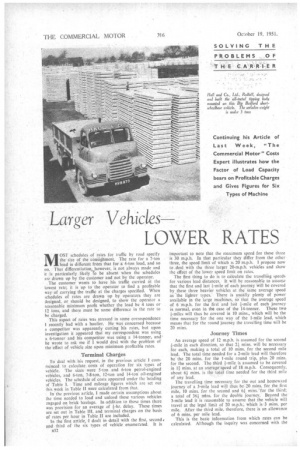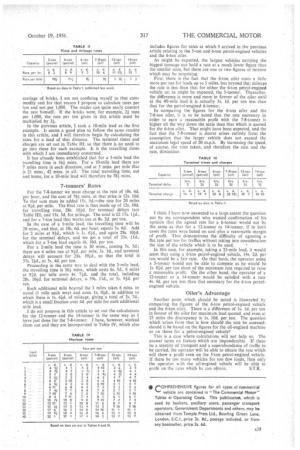Larger - V ehicles
Page 66

Page 69

If you've noticed an error in this article please click here to report it so we can fix it.
LOWER RATES
MOST schedules of rates for traffic by road specify the size of the consignment. The rate for a 7-ton load is different from that for a 4-ton load, and so on. That differentiation, however, is not always made and it is particularly likely to be absent when the schedules are drawn up by the customer and not by the operator.
The customer wants to have his traffic carried at the lowest rate; it is up to the operator to find a profitable way of carrying the traffic at the charges specified. When schedules of rates are drawn up by operators they are designed, or should be designed, to show the operator a reasonable minimum profit whether the load be 4 tons or 12 tons, and there must be some difference in the rate to he charged. This aspect of rates was stressed in some correspondence I recently had with a haulier. He was concerned because a competitor was apparently cutting his rates, but upon investigation it appeared that my correspondent was using a 6-tonner and his competitor was using a 14-tanner, and' he wrote to ask me if I would deal with the problem of the effect of vehicle size upon minimum profitable rates.
Terminal Charges
To deal with his request, in the previous article I commenced to calculate costs of operation for six types of vehicle. The sizes were 5-ton and 6-ton petrol-engined vehicles, and 6-ton, 7-8-ton, 12-ton and 14-ton oil-engined vehicles. The schedule of costs appeared under the heading af Table I. Time and mileage figures which are set out this week in Table 11 were calculated from that. In the previous article, 1 made certain assumptions about the time needed to load and unload these various vehicles engaged on brick haulage. In addition to those times there was provision for an average of 1-hr. delay. These times are set out in Table III, and terminal charges on the basis of rates per hour in Table II are included. In the first article, I dealt in detail with the first, second. and third of the six types of vehicle enumer'ated. It is n32
important to note that the maximum speed for these three is 30 m.p.h. In that particular they differ from the other three, the speed limit of which IS 20 m.p.h. I propose now to _deal with the three larger 20-m.p.h. vehicles and show the effect of the lower speed limit on rates.
The first thing to do is to calculate the travelling speeds for various lead distances. It will be reasonable to assume that the first and last finite of each journey 'will be covered by these three heavier v,ehicles at the same average speed as thelighter types: There is usually plenty of power available in the large machines, So that the average speed of 6 m.p.h. for the first and laSt i-mile of each journey is normal, even in the case of the 14-tonner. These two -mites will thus be covered in 10 mins., which will be the time necessary for the one way of the 1-mile lead, which means that for the round journey the travelling time will be 20 mins.
Journey Times
An average speed of 12 m.p.h. is assumed for the second 1-mile in each direction, so that 21 mins. will be necessary for each, making a total of 10 mins. for the second mile lead. The total time needed for a 2-mile lead will therefore be the 20 mins. for the 1-mile round trip, plus 20 mins. for the second. The third -}-mile is assumed to be covered in I?, mins. at an average speed of 18 m.p.h. Consequently, about 61 mins, is the total time needed for the third mile of any lead.
The travelling time necessary, for the out and homeward journey of a 3-mile lead will thus be 20 mins. for the first mile, 10 mins. for the second and N, mins. `for the third; a total of 361 'reins. for the double journey. Beyond the 3-mile lead it is reasonable to assume that the vehicle will travel at the legal limit of 20 m.p.h.', which is.3 mins. per mile. After the third mile, therefore, there is an allowance of 6 mins, per mile lead.
This is the basic information from which rates can be calculated. Although the inquiry was concerned with the
carriage. of ,bricks, I am not confining myself to that commodity and for that reason I propose to calculate rates per ton and not per .1,000. The reader can quite easily convert the rate himself. If the bricks were; for example, 21 tons per 1,000, the rate per ton given in this article must be multiplied by 2.
In the previous article, I took a 10-mile lead as the first example. It seerns-a good plan to follow the same routine in this article, and I will therefore begin by calculating the rates for a lead of that distance. The terminal times and charges' are set out in Table Ill, so that there is no need to go into these for each example. It is the travelling times with which I am immediately concerned,
It has already been established that for a 3-mile lead the travelling time is 361 mins. For a 10-mile lead there are 7 miles more in each direction, and at 3 mins. per mile that is 21 mins., 42 mins, in all. The total travelling time, out and home, for a 10-mile lead will therefore be 781 mins.
7-tonners' Rates For the 7-8-tanner we must charge at the rate of 10s. 6d, per hour, and the cost of 781 mins, at that price is 12s. 10d. To that sum must be added 15s. 51-the rate for 20 miles at 9ld. per mile. The final rate is thus made up of 12s. 10d. for travelling time, 28s. 101d. for terminal delays (see Table III), and 15s. 5d. for mileage. The total is £2 17s. lid., and for a 7-ton load that works out at 8s. 2d. per ton.
In the case of a 1-mile lead, the travelling time will be 20 mins., and that, at 10s. 6d. per hour, equals 3s. 6d. Add for 2 miles at NA., which is Is. 60., and again 28s. 101d. for the terminal delays, and we get a total af 33s. lid., which for a 7-ton load equals 4s. 10d. per ton.
For a 2-mile lead the time is 30 mins., costing 5s. 3d.; there are 4 miles run at 91d. per mile, 3s. Id., and terminal delays will account for 28s, 1011, so that the total is 37s. 21d., or 5s. 4d. per ton. Proceeding in the same way to deal with the 3-mile lead, the travelling time is 361 mins., which costs 6s. 5d„ 6 miles at 91d. per mile costs 4s. 71d.. and the total, including 28s. 100, for terminal delays, is 39s, 11d., or 5s. 91d. per ton.
, Each additional mile beyond the 3 miles takes 6 mins. to travel (1 mile each way) and costs is. Old., in addition to which there is Is. 61d, of mileage, giving a total of 2s. 7d., which is a small fraction over 4d. per mile for each additional mile lead.
I do not propose in this article to set out the calculations for the 12-tanner and the 14-tanner in the same way as I have just done for the 7-8-tonner. I have, however, worked them out and they are incorporated in Table IV, which also includes figures for rates at which I arrived in the previous article relating to the 5-ton and 6-ton petrol-engined vehicles and the 6-ton oiler.
As might be expected, the largest vehicles carrying the biggest tonnage can hold a rate at a much lower figure than the smaller ones, but there are one or two figures of interest which may be surprising.
First, there is the fact that the 6-ton oiler costs a little more per ton for leads up to 3 miles, but beyond that mileage the rate is less than that for either the 6-ton petrol-engined vehicle or, as might be expected, the 5-tonner. Thereafter, the difference is more and more in favour of the oiler until at the 40-mile lead it is actually 3s. Id. per ton less than that for the petrol-engined 6-tonner.
• In comparing the figures for the 6-ton oiler and the 7-8-ton oiler, it is to be noted that the rate necessary in order to earn a reasonable profit with the 7-8-tanner is higher all the way down the scale than that which is quoted for the 6-ton oiler. That might have been expected, and the fact that the 7-8-tanner is dearer arises entirely from the assumption that the larger vehicle does not exceed the maximum legal speed of 20 m.p.h. By increasing the speed, of course, the time taken, and therefore the cost and the rate, diminishes I think I have now answered to a large extent the question put by my correspondent who wanted confirmation of his opinion that the agreed rate for a 6-tanner would not be the same as that for a 12-tanner of 14-tonner, if in both cases the rates were based on cost plus a reasonable margin of profit. That demonstrates the difficulty of agreeing a flat rate per ton for traffics without taking into consideration the size of the vehicle which is to be used. •
In this case, for example, taking a 25-mile lead, it would seem that using a 6-ton petrol-engined vehicle, 14s, 2d. per ton would he a fair rate. On that basis, the operator using a 5-tanner would not be able to compete as he Would be Is. 01d, per ton short of the minimum rate required to raise a reasonable profit. On the other hand, the operator of a 12-tonner or a 14-tanner would be .satisfied with a rate 4s. 4d. per ton less than that necessary for the 6-ton petrolengined vehicle.
Oiler's Advantage.
Another point which should be noted is illustrated by comparing the figures of the 6-ton petrol-engined vehicle and the 6-ton oiler. There is a difference of 3s. Id. per ton in favour of the oiler for maximum lead quoted, and even az 25 miles the discrepancy is is. 10d. per ton. The question which arises from that is how should the rate be assessed: should it be based on the figures for the Oil-engined machine or on those for a petrol-engined vehicle?
This is a case where calculations will not help us. The answer turns on factors which are imponderable. If there be a scarcity of transport and a superabundance of traffic to be carried, the operator will 'beable to obtain the rate which will show a proht even on the 5-ton petrol-engined vehicle, If there be too many vehicles for too few loads, then only the operator with the oil-engined vehicle will be able to
profit on the rates which he, can obtain. S.T.R.




































































































